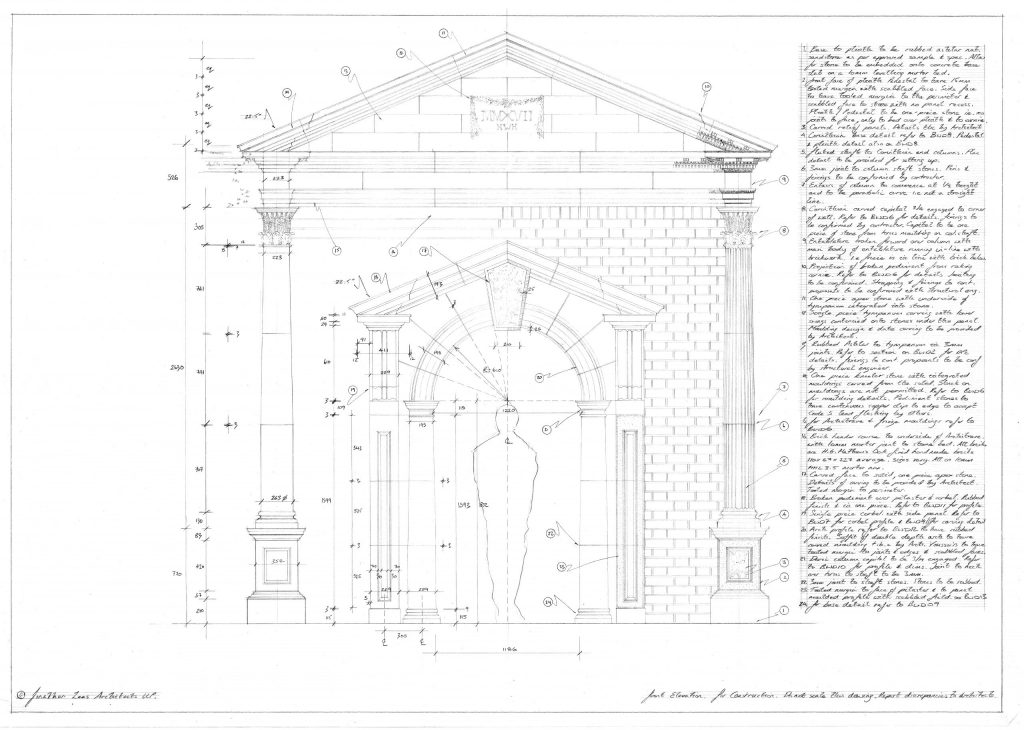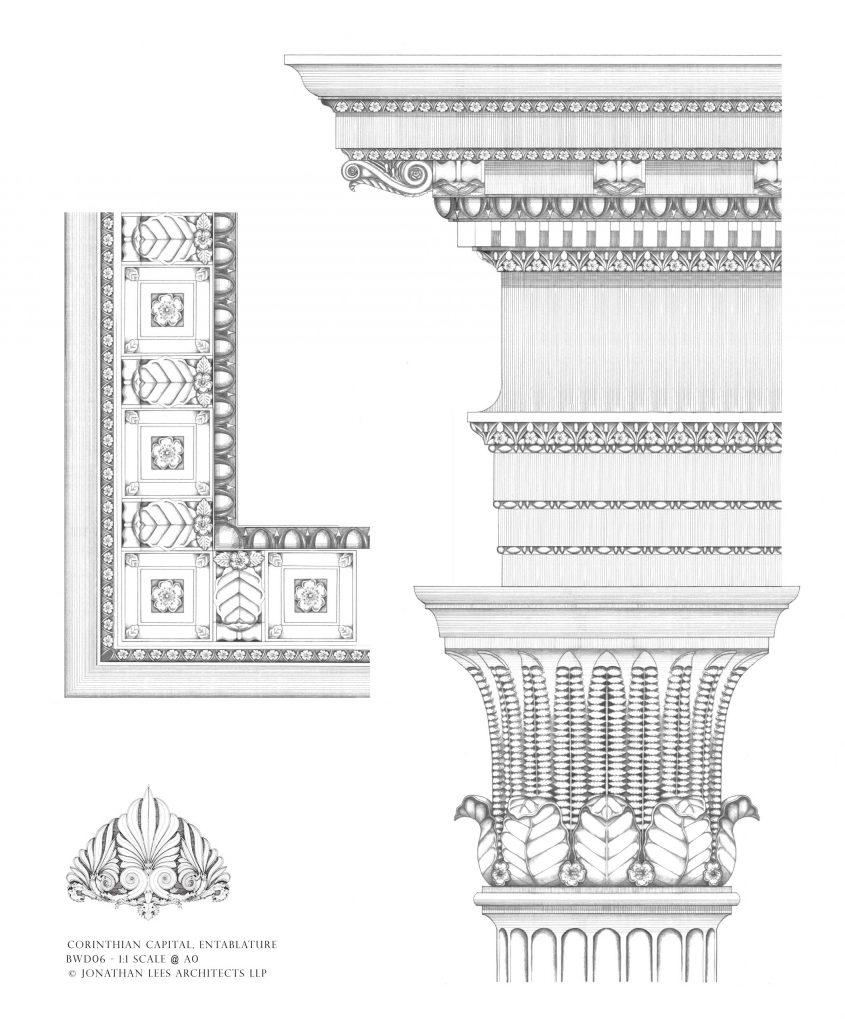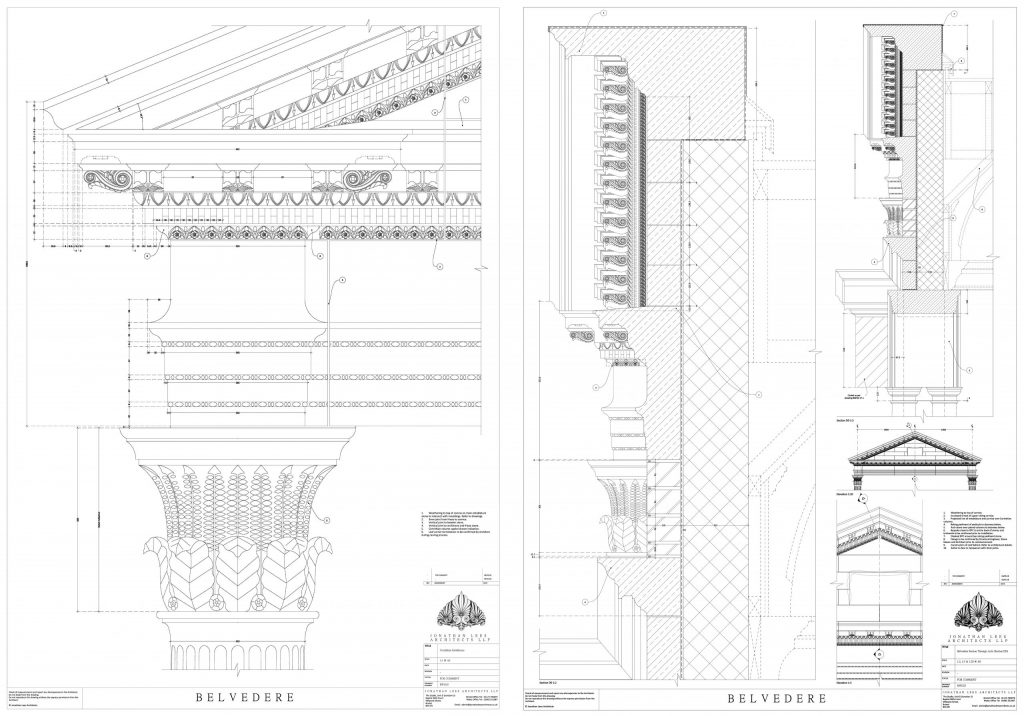Project Series
The Belvedere Garden Folly
– an award winning building
Written by Jonathan Lees RIBA.
‘…… a testament to the love of architecture and design that the client and I shared.’
The Belvedere is a folly structure built in the grounds of an Arts & Crafts inspired country house estate that we have been developing for the past six years. This small garden building is a testament to the love of architecture and design that the client and I shared. The purpose of the Belvedere is purely a viewing platform to look back at the house and beautifully planted gardens. The intention was to celebrate the many themes invented so far throughout the estate and the progression and development of a unique architectural language for this legacy project.
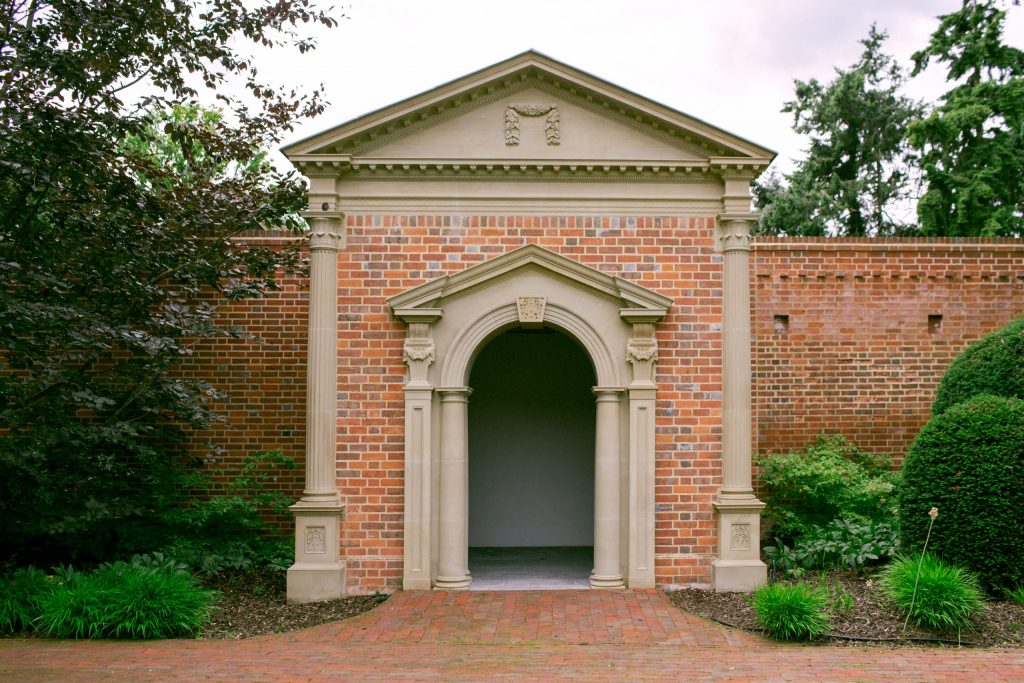
The Belvedere built against the tall brick garden wall
As with many of the buildings on the site, the idea for the Belvedere was not originally part of the concept for the main house, it was developed through general conversation with the client and at a time when we were discussing the garden structures. The main South boundary wall to the gardens were being rebuilt, along with the historic arch that was present on the Western side of the wall. We wanted to do something that expressed the access line from the orangery frontis that passed through the centre of the swimming pool in the South gardens, and from memory I had the idea of creating a structure that would terminate this access line, such as a sculpture or small garden structure.
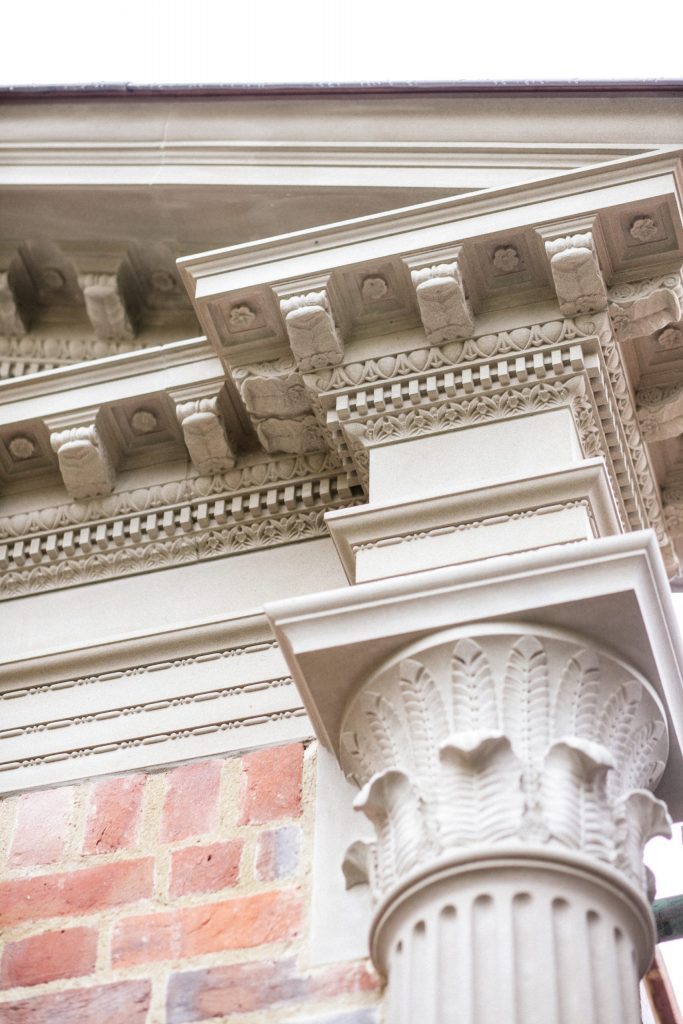
Details of the intricate carved column and entablature
‘The building has won the
Natural Stone Awards
‘Craftsmanship’ category (2021)’
The building has won the Natural Stone Awards ‘Craftsmanship’ category (2021) and was noted for ‘the evident attention to detail and classical detailing that is not from any copy book but has evolved into its own language and style in an imaginative way. Carved and executed with exceptional sensitivity and precision by the skilled masons at A F Jones’. We are immensely proud of the work produced.
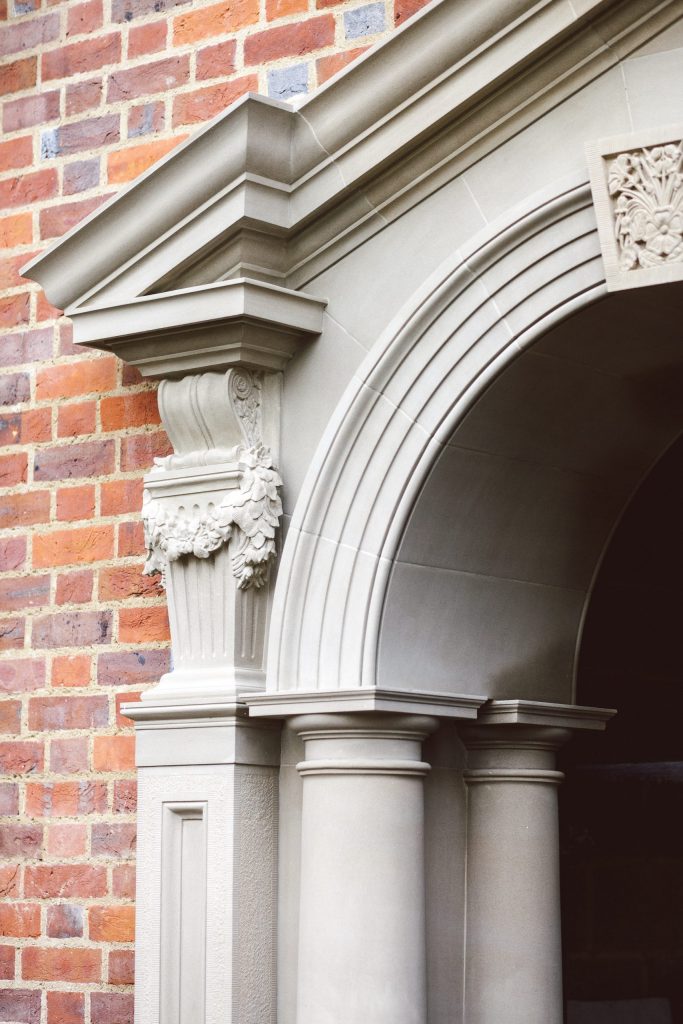
Inpost, column and keystone details
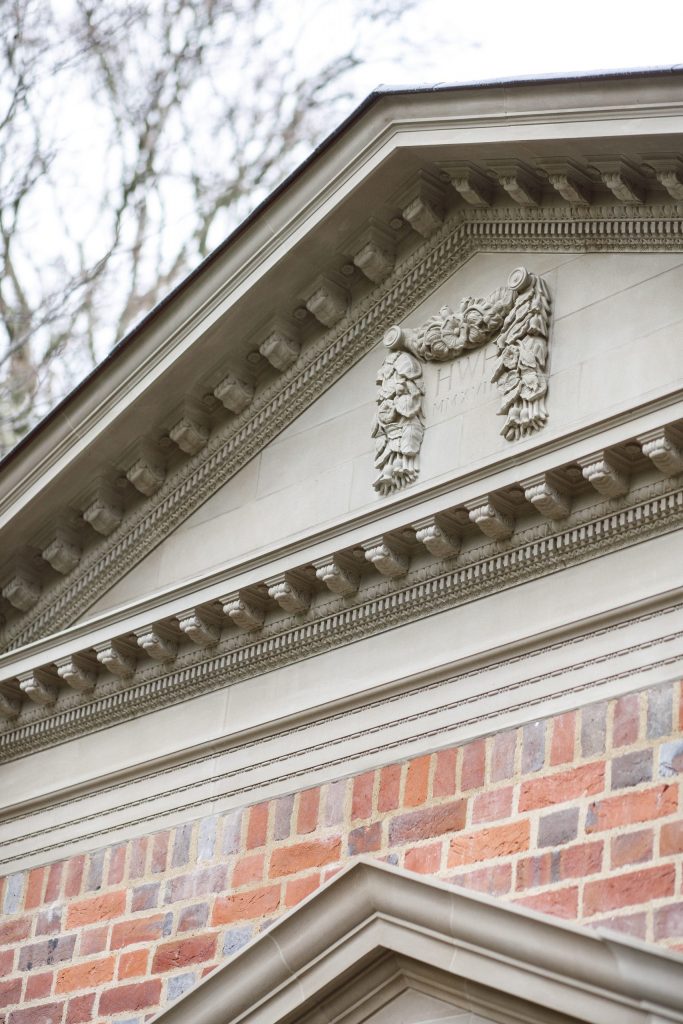
Cartouche and entablature details
The design of the Belvedere focused on columns set on their pedestals with a heavy plinth course. The order was developed on the proportions of the Corinthian column, being more slender and elegant than those proportions used in the main house. The columns are three-quarters engaged and wrap around a side elevation allowing the entablature above to envelope and form a formal frontis to the small structure. The pedestal to the columns give the structure the extra height that it required in order to form a decorative aedicule to the entrance.
Sketch design of the Belvedere
‘I wished to celebrate a more elaborate and flamboyant approach to the decoration…..’
I wished to celebrate a more elaborate and flamboyant approach to the decoration of the masonry elements than that developed on the main house. The front face of the pedestal is adorned with one of the patterns developed across the site, which is a simple tooled margin to the outer extent of the stone with approximately twenty bats per inch of lined tooling with a scabbled field to the centre. The inner field of the pedestal includes a carved motif of beech leaves with dogwood roses and bluebells surrounded by a simple cyma moulding and tooled margin, which is a common feature on the main house.
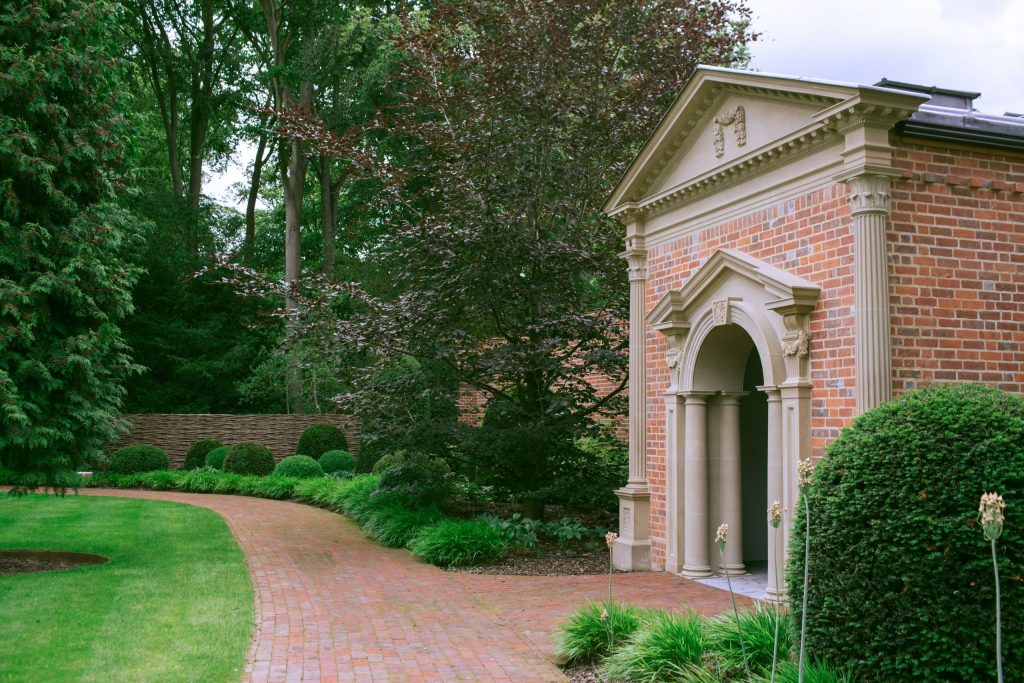
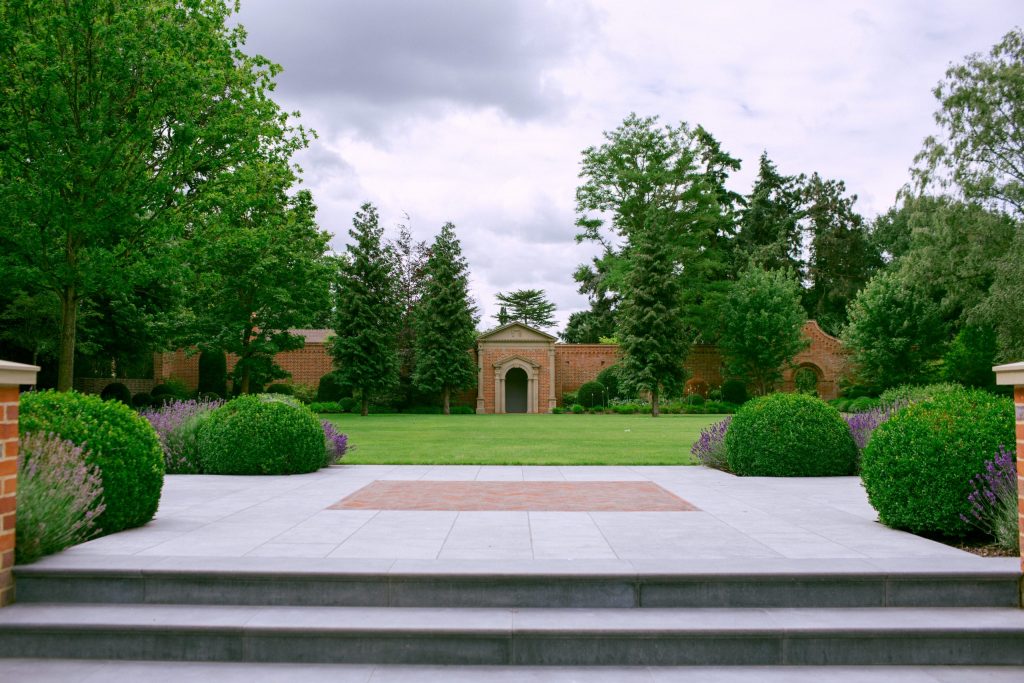
Nestling in the garden
The geometry and principals used for the structure are based on a series of proportions also developed for the main house and include references to the golden section and harmonic proportions, forming a geometrically perfect structure.
Andrea, Lydia and I had some fun with this design and developed the detail of the full Corinthian entablature as an entirely new order, basing it on the Corinthian details developed by Palladio and Serlio along with the stylistically opposing austerity of the Neo-Classical Temple of the Tower of the Winds from Ancient Greece. The lower bead and reel mouldings to our architrave, with the architrave broken into three sections is common place, however the cyma moulding above that separates the architrave and frieze and the cyma moulding to the upper cornice, are adorned with bluebell and rose mouldings carved by hand. The dentil course, and egg-and-dart course above, project out to support a deep corona with carved brackets, or consoles under. These carved consoles, which take the form of a voluted scroll, are also adorned with bluebells. Small roses are on the centre of each scroll and a beech leaf follows the curved underside of each and every one of the consoles. Everything is carved by extraordinarily skilled hands and designed by my team to meticulous detail.
‘…… the entablature and the raked pediment was one of the more time consuming tasks.’
CAD details of the column and raking entablature
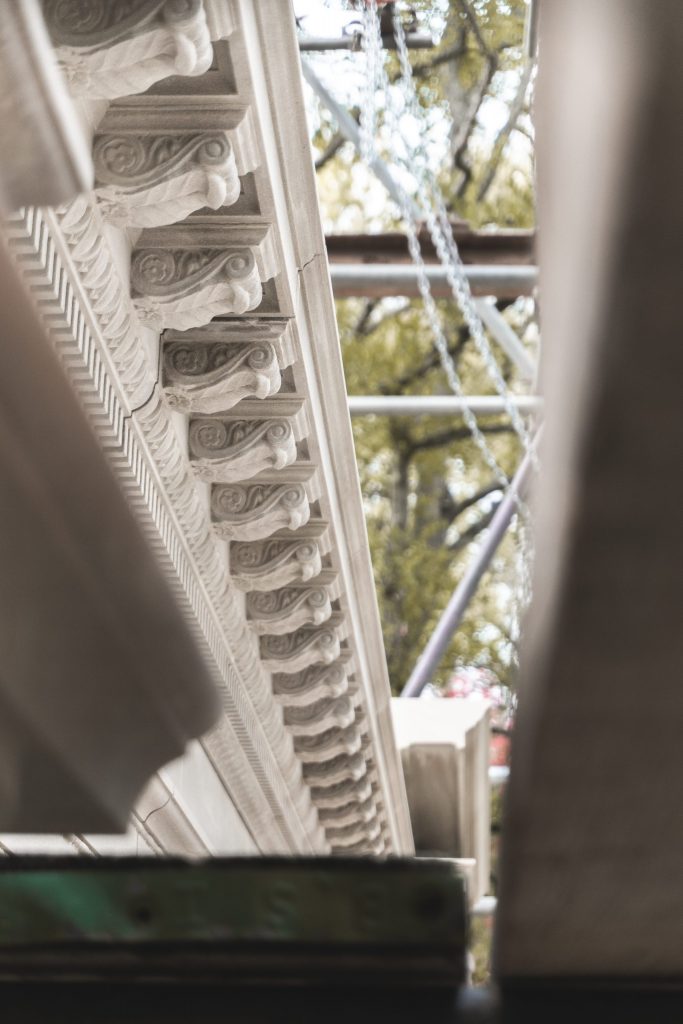
The raking entablature being installed
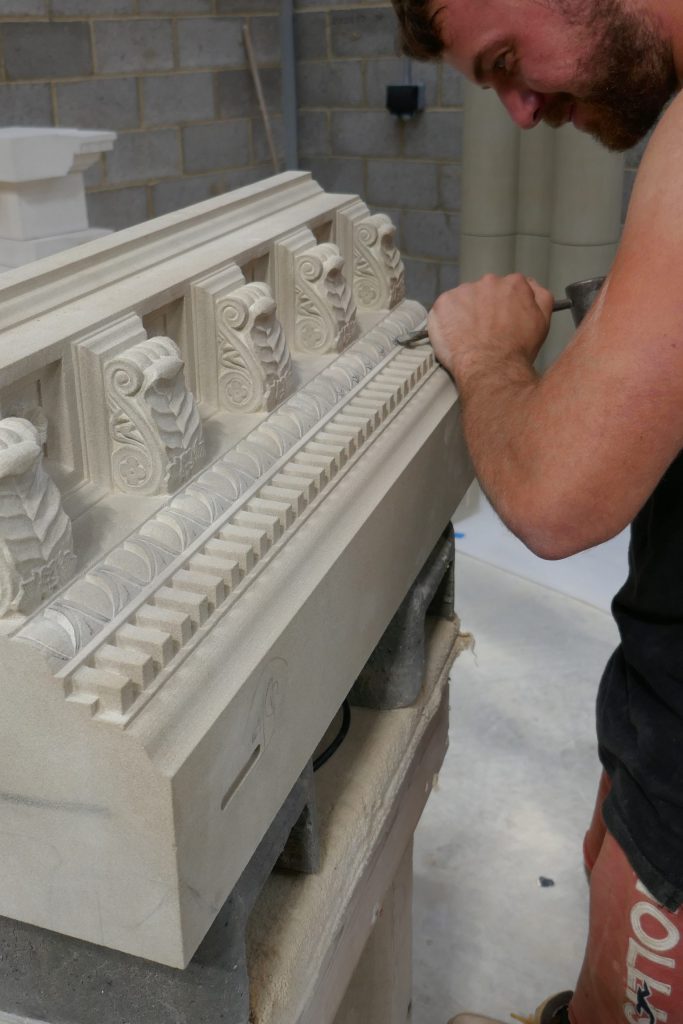
The entablature being carved in the workshop
The raking pediment posed a significant design challenge with how to proportion the corbel consoles. Many examples of Corinthian entablatures found throughout the world show the brackets perpendicular to the raking cornice, however, I wanted to observe the scholarly manner in which to use this detail, and how the detail would have been proposed by the likes of Palladio and Serlio and their followers in 18th and 19th Century Britain. With this in mind, the consoles were developed in a skewed manner so that their sides were vertical and the volutes forming the consoles were distorted to suit the direction of the raked cornice over. Inspiration for this was gathered from Chiswick House, a fine example of the method used designed by Lord Burlington in the Palladian manner, where the consoles follow this scholarly pattern. The setting out of the entablature and the raked pediment was one of the more time consuming tasks involved with drawing and setting out the structure and took meticulous consideration by Andrea and I during the design development.
‘…… a swag of beech and rose leaved with bluebells falling from the lower limbs…...’
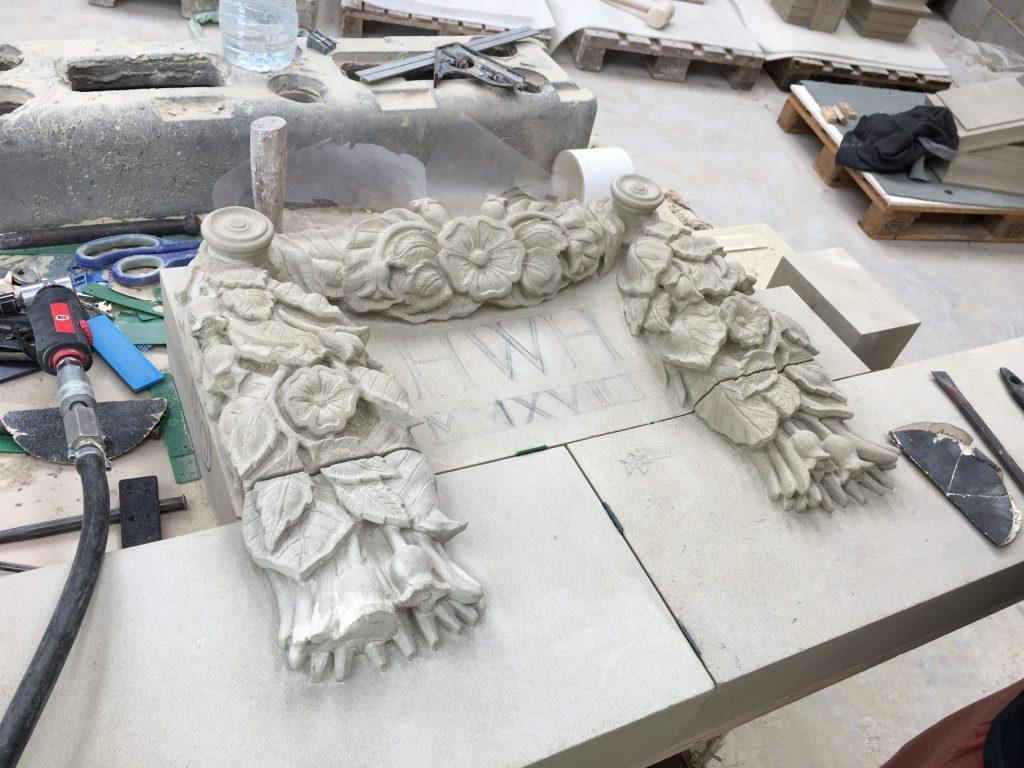
Cartouche being carved in the workshop by the masons at A.F.Jones
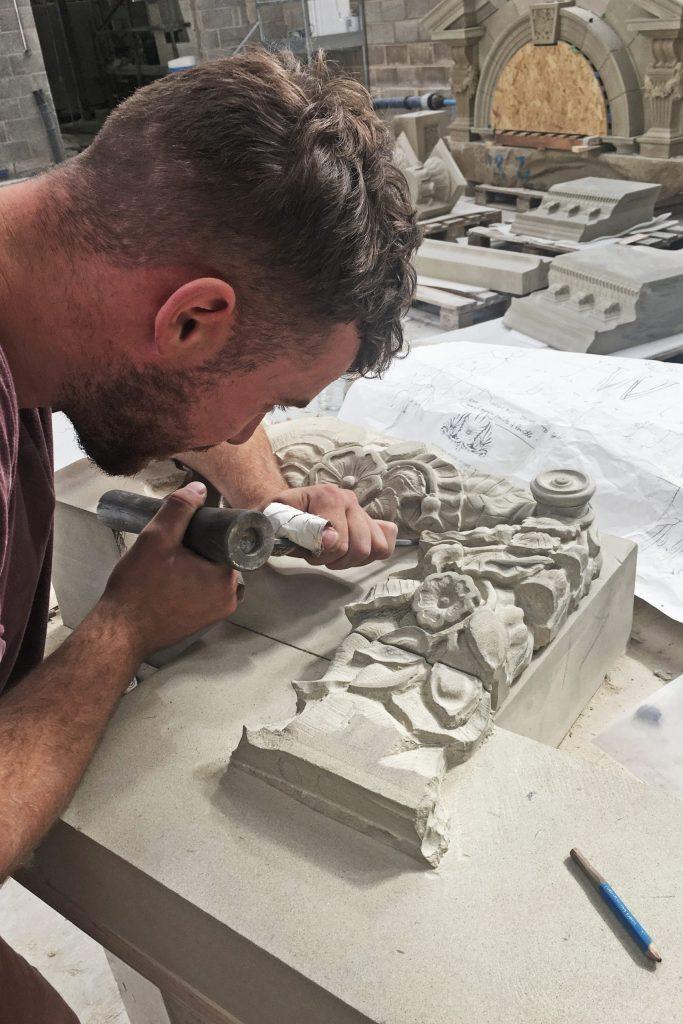
Carving and installation of the Cartouche by A.F. Jones
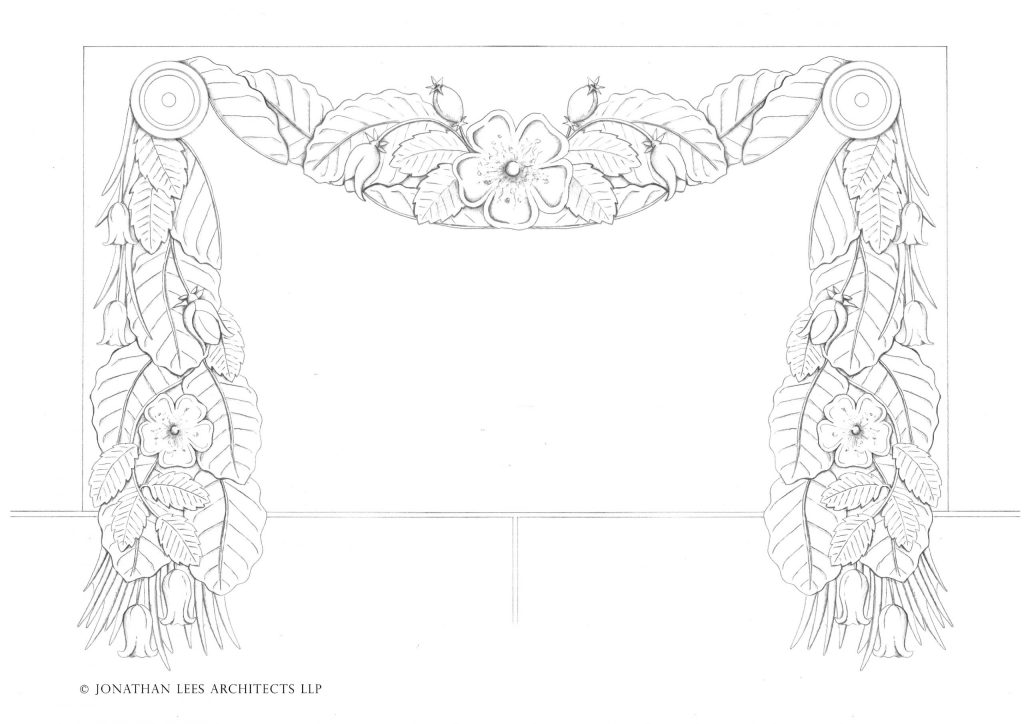
The cartouche design in pencil
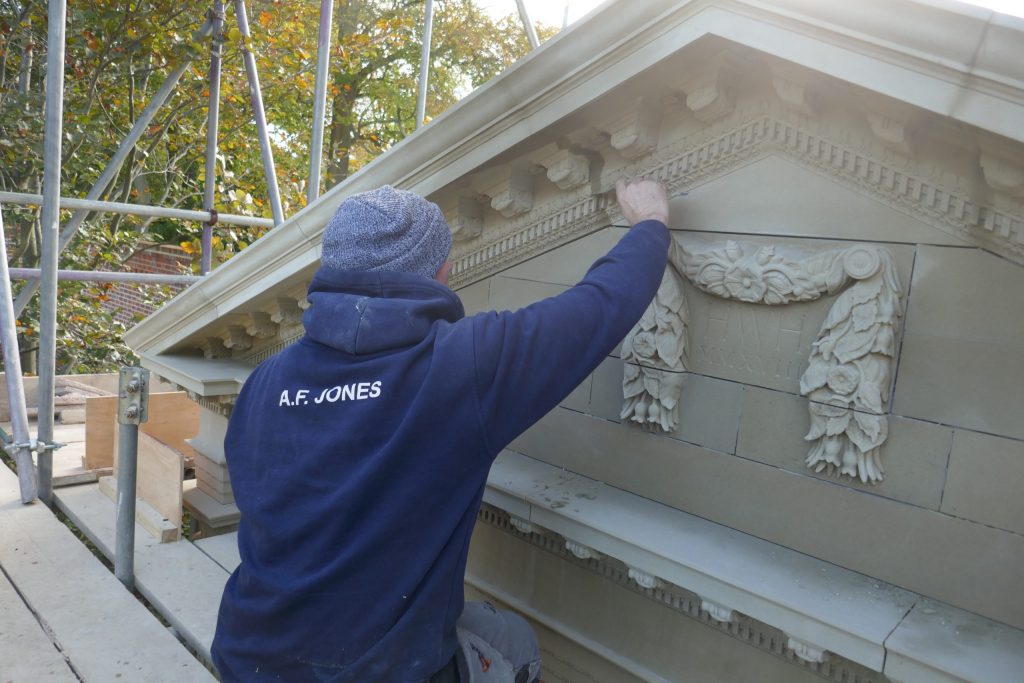
The unique aedicule surround was a development of details previously used in the main house to the fireplaces and other areas, and includes a set of paired Doric columns carrying an arch with an expressed architrave moulding and carved keystone to the centre. This is set forward of the main building line to allow for squared pilasters flanking the Doric columns to punch out, with the tooled margin and scabbled field to the centre and edges of the pilaster developing the detail used in the pedestal to the outer columns.
The pilasters carry an inverted in-post, which is a development we invented in a subtle detail to the fireplace in the orangery to the main house. This was then taken a step further for the Belvedere. The in-post is set over the pilaster capital with unique mouldings to both the pilaster capital and the in-post that are found only on this estate. The front and side faces of the in-posts are fluted and carry a small corbel console over, supporting a broken, raking pediment that is set back in line with the arch over. The carving around the in-posts matches that of the swags to the tympanum, with beech leaves, bluebells and a rose to the centre being carved in one piece of stone with the swag passing up to the lower curve of the console, as if the swag was growing from the stone.
‘A tight, dense English sandstone was used in order to provide the very best quality…..‘
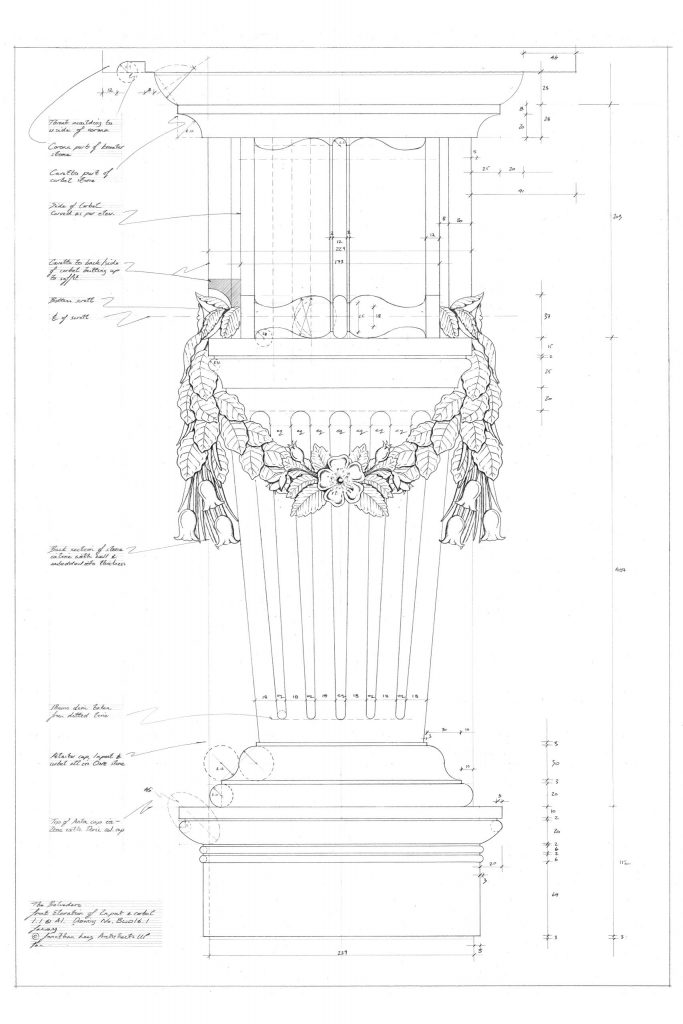
Hand drawn design of the in-post
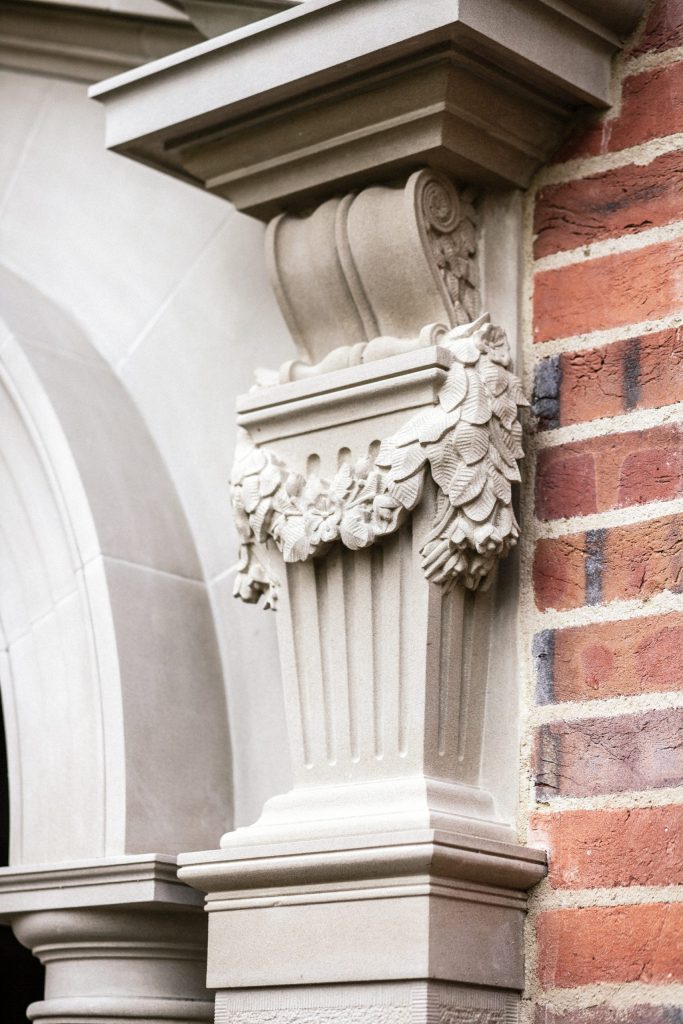
The carved in-post set in position
The masonry details are expressed with the use of H.G.Matthews’ Oak-fired handmade plum bricks, that are also used on the main house. A header course under the entablature expresses the solidity and horizontal emphasis of the pediment over the main doorway, with a lower level of creasing tiles expressing the plinth moulding to the pedestals.
The playful character and detailing of the Belvedere needed to be matched and exceeded by the quality of the craftsmanship and the skill involved in making the structure and developing the drawings into reality. AF Jones Stonemasons were employed to take the meticulous set of working drawings that Andrea, Lydia and I produced to realise this vision.
A tight, dense English sandstone was used in order to provide the very best quality of stone for the carving. The sandstone used for the main house was not dense enough in order to carry the carved details that were proposed for the Belvedere, so a stone similar in colour was used but with a much tighter grain. Although this meant natural features were less prominent, it allowed the detail in the carvings to shine through without creating a busy texture to the face of the stone that would otherwise detract from the carved details. The stone was also chosen in order to compliment the traditional quality of the brickwork which is a vital detail in the architectural appearance.
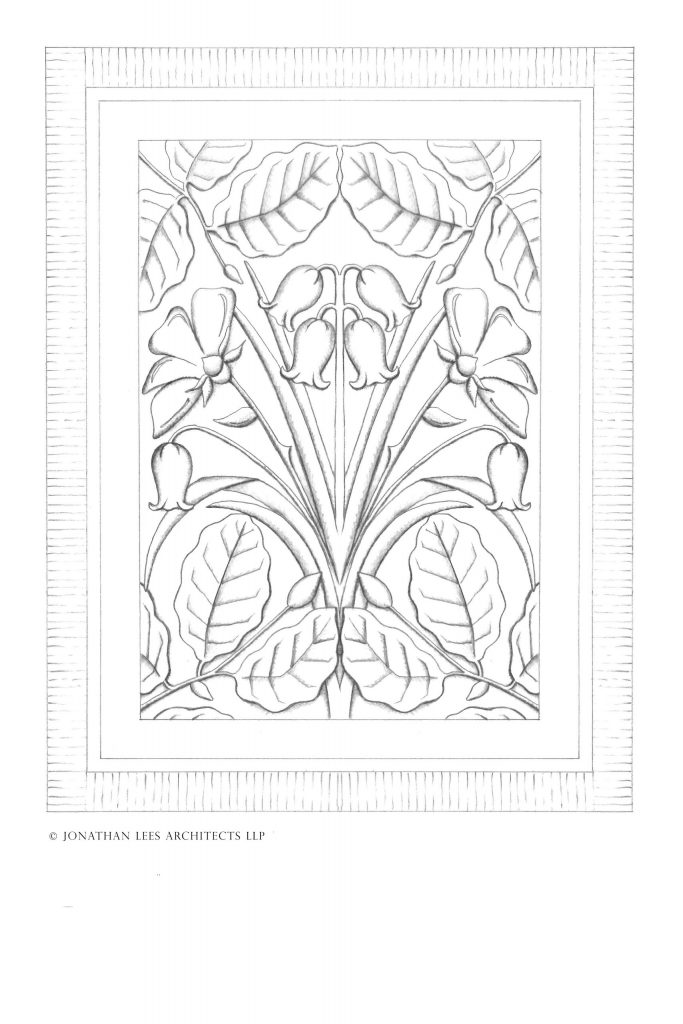
Hand drawn design of the in-post
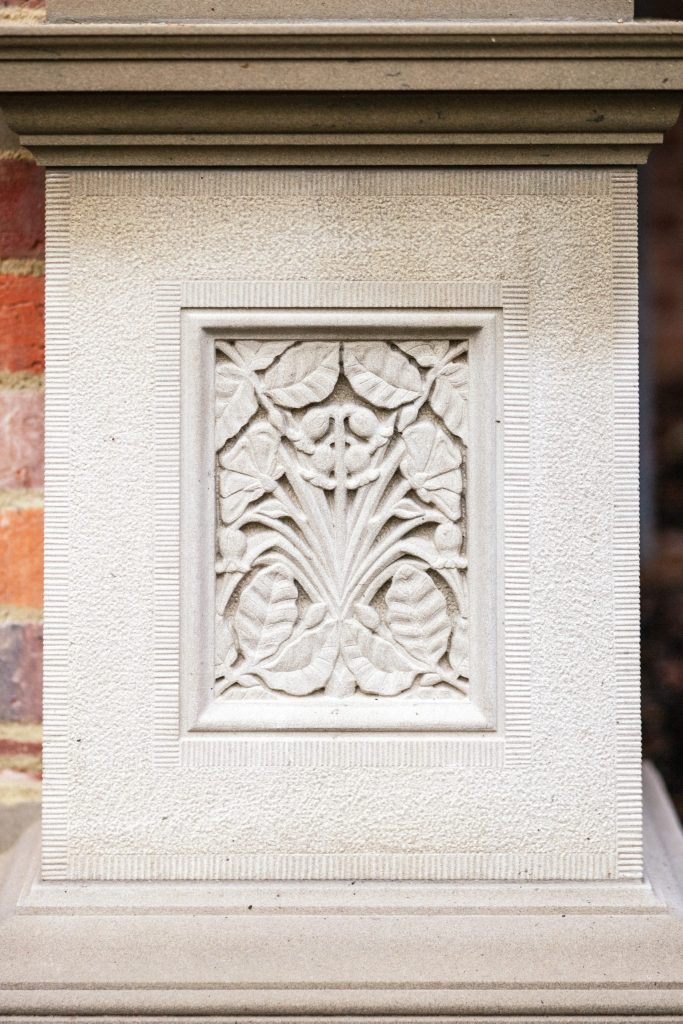
Carved detail in column base
‘….highly talented individuals, who took our detailed pencil sketches and developed them into 3d pieces of art in stone.‘
The detailing produced in our sketches and working drawings was met by the Stonemasons, who produced further detailed working drawings and setting out information that were developed in a very successful collaborative approach to the design process.
The technology used in the design and manufacture of the masonry was testament to the inventiveness of the design, with the latest five axis CNC machines being used to create the individual blocks and to waste away material in an economic manner. Details such as the in-posts, the Tympanum and the cornice were worked first on the machines and then finished by the hands of a small number of highly skilled stone carvers, who worked on the project throughout. These carvers range from extremely experienced and wonderful Artisans to young, highly talented individuals, who took our detailed pencil sketches and developed them into 3D pieces of art in the stone. We made visits to the Stonemason’s yard to work with carvers and to develop the details from sketch to stone.
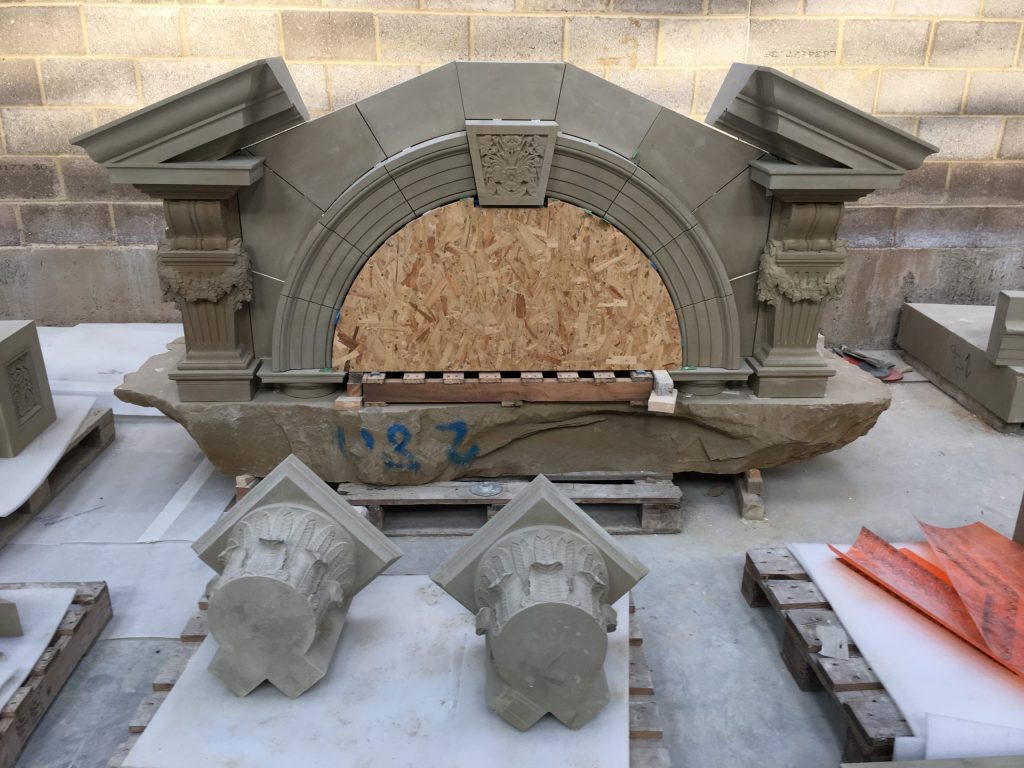
Freshly carved and waiting to be delivered to site
An important factor overall was to ensure that the hand, or style of the carver was expressed in the completed work. The playful nature of the mouldings and details in the main house were not developed in a rigid Baroque, or Georgian manner whereby they demanded a symmetry and precision as if they were taken from a pattern book. The motifs and features are unique, site-specific designs that allow the hand of the artists who developed them, to work the details out and to ensure that, although symmetry was applied, each and every detail has it’s own character and variation, much as they would have in nature. Each and every one of the leaf mouldings was checked and discussed throughout the process. Lydia and I worked closely with John and Gabriel from AF Jones to realise the vision and design sketches and to turn them into reality.
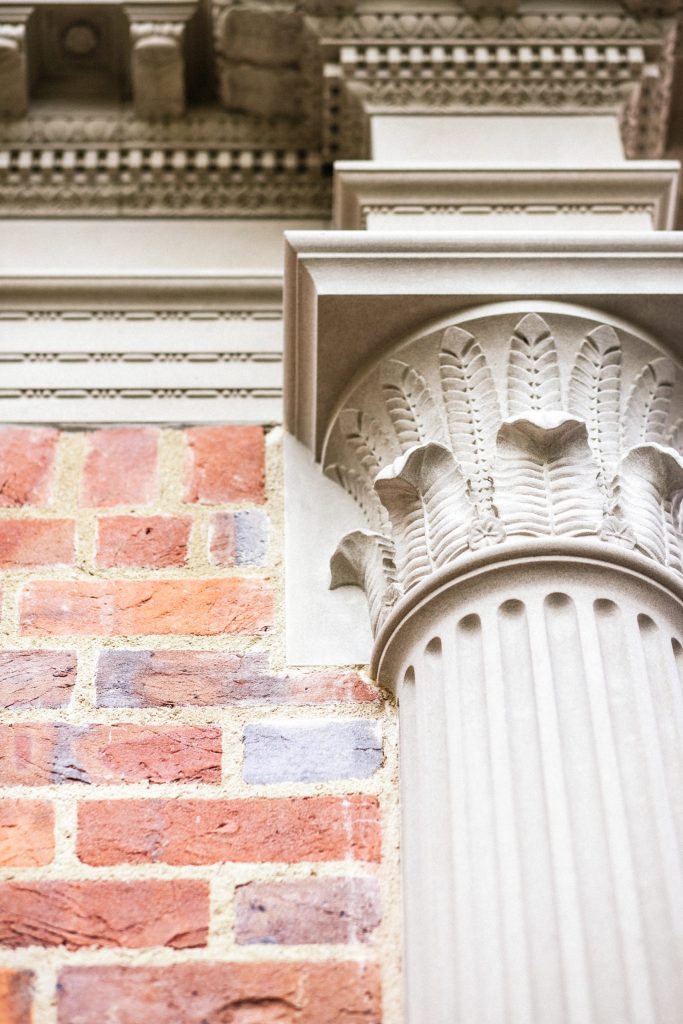
Hand drawn design of the in-post
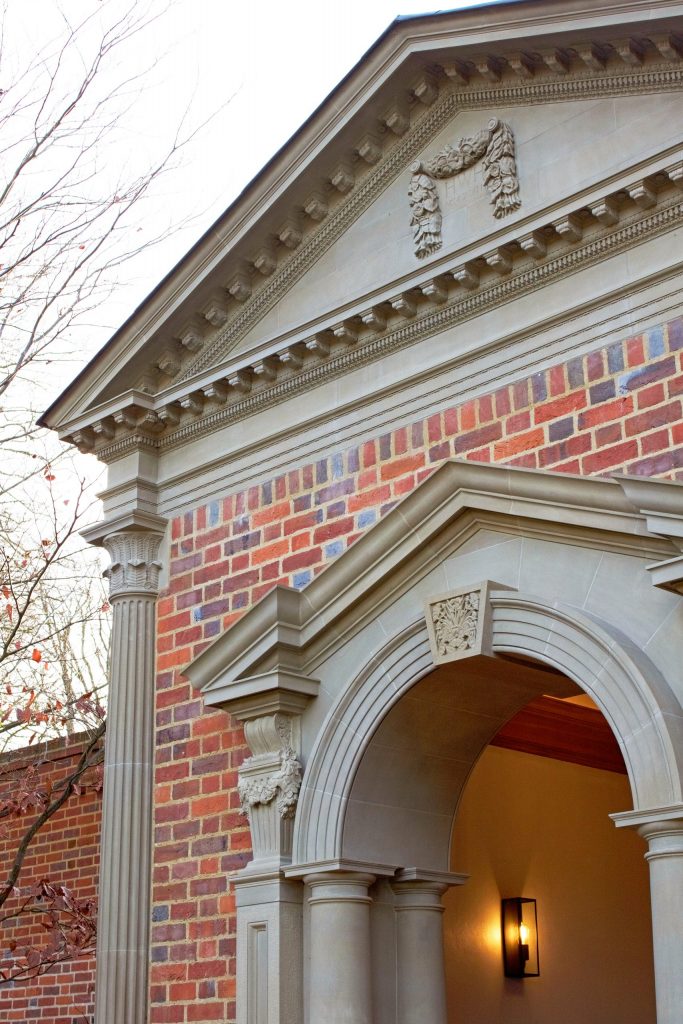
Carved detail in column base
The time, dedication and hard work of everyone involved has resulted in a piece of architecture that has exceeded both ours and the client’s expectations. The skill of the Stonemasons in the carving was matched by the skill of those fixing masons who completed the site installation that was carried out meticulously over a number of weeks.
Although a small structure, my intention was that the Belvedere should be viewed up close. The view from the distance of the orangery to the main house was designed to express the shape and form of the columns and pediment over, creating interest to the otherwise plain garden wall at the Southern end of the site.
The Belvedere is testament to a successful collaborative approach and to the fusion of inventive detail where modern manufacturing techniques and traditional hand carving skills have together created something unique in a setting where it can be celebrated.
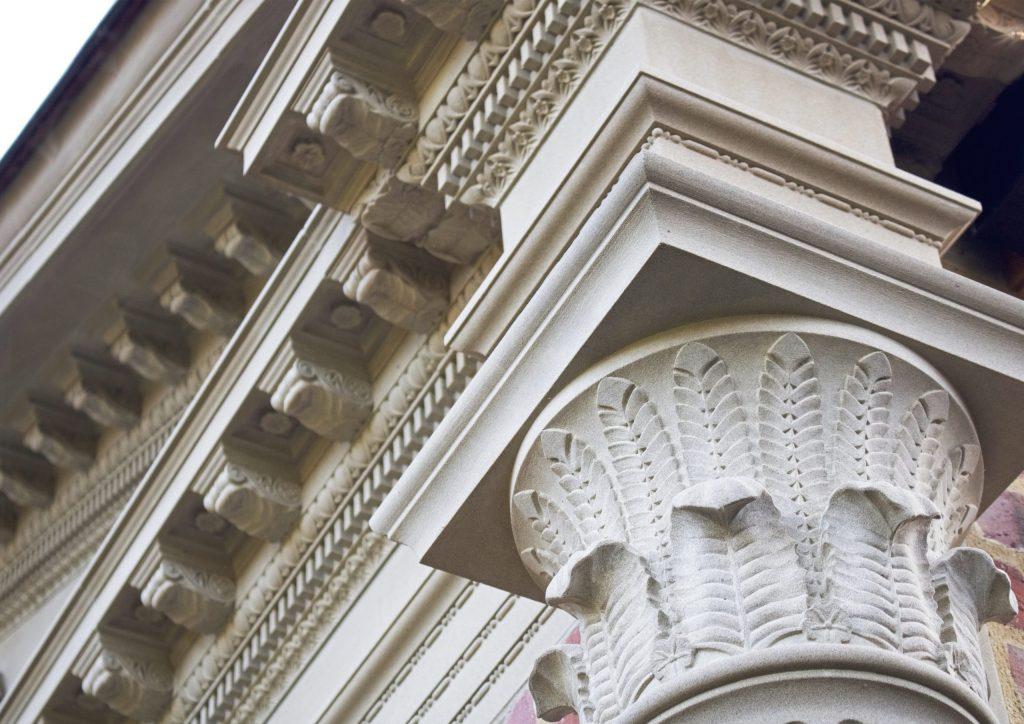
Award winning craftsmanship
Return to the Writings Library for more essays and Project Profiles

